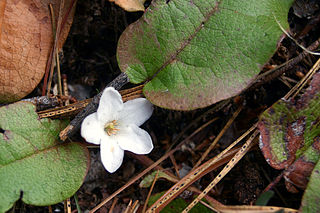
Kalmia latifolia, the mountain laurel, calico-bush, or spoonwood, is a species of flowering plant in the heath family Ericaceae, that is native to the eastern United States. Its range stretches from southern Maine south to northern Florida, and west to Indiana and Louisiana. Mountain laurel is the state flower of Connecticut and Pennsylvania. It is the namesake of Laurel County in Kentucky, the city of Laurel, Mississippi, and the Laurel Highlands in southwestern Pennsylvania.

Acer saccharinum, commonly known as silver maple, creek maple, silverleaf maple, soft maple, large maple, water maple, swamp maple, or white maple, is a species of maple native to the eastern and central United States and southeastern Canada. It is one of the most common trees in the United States.

Ranunculus acris is a species of flowering plant in the family Ranunculaceae, and is one of the more common buttercups across Europe and temperate Eurasia. Common names include meadow buttercup, tall buttercup, common buttercup and giant buttercup.

Epigaea repens, the mayflower, trailing arbutus, or ground laurel, is a low, spreading shrub in the family Ericaceae. It is found from Newfoundland to Florida, west to Kentucky and the Northwest Territories.

Jeffersonia, also known as twinleaf or rheumatism root, is a small genus of herbaceous perennial plants in the family Berberidaceae. They are uncommon spring wildflowers and grow in limestone soils of rich deciduous forests. Jeffersonia was named for United States President Thomas Jefferson by his contemporary Benjamin Smith Barton. This genus was formerly grouped in genus Podophyllum. Twinleaf is protected by state laws as a threatened or endangered plant in Georgia, Iowa, New York, and New Jersey.

Viburnum prunifolium is a species of Viburnum native to eastern North America, from Connecticut west to eastern Kansas, and south to Alabama and Texas.

Senna hebecarpa, with the common names American senna and wild senna, is a species of legume native to eastern North America.

Cardamine diphylla is a flowering plant in the family Brassicaceae. It is a spring flowering woodland plant that is native to eastern North America.

Liatris spicata, the dense blazing star, prairie feather, gayfeather or button snakewort, is a herbaceous perennial flowering plant in the family Asteraceae. It is native to eastern North America where it grows in moist prairies and sedge meadows.

Viburnum nudum is a deciduous shrub in the genus Viburnum within the muskroot family, Adoxaceae.

Pseudognaphalium obtusifolium, synonyms including Gnaphalium obtusifolium and Pseudognaphalium saxicola, is a member of the family Asteraceae. It is found on open dry sandy habitat throughout eastern North America. Common names include old field balsam, rabbit tobacco and sweet everlasting. When crushed, the plant exudes a characteristic maple-syrup scent.

Iris virginica, with the common name Virginia blueflag, Virginia iris, great blue flag, or southern blue flag, is a perennial species of flowering plant in the Iridaceae (iris) family, native to central and eastern North America.

Lythrum alatum, commonly known as winged loosestrife, winged lythrum or angled purple-loosestrife, is a species of flowering plant belonging to the family Lythraceae. It is endemic to wetland areas in central and eastern United States and Ontario.

Blephilia hirsuta, commonly known as hairy wood-mint or hairy pagoda plant, is a species of herbaceous perennial in the mint family Lamiaceae. It is native to eastern North America.

Blephilia ciliata is a species of herbaceous perennial plant in the Lamiaceae (mint) family native to central and eastern North America. It is commonly called downy wood mint. Other common names include downy pagoda-plant, sunny woodmint and Ohio horsemint.
This is a list of plants used by the indigenous people of North America. For lists pertaining specifically to the Cherokee, Iroquois, Navajo, and Zuni, see Cherokee ethnobotany, Iroquois ethnobotany, Navajo ethnobotany, and Zuni ethnobotany.

Solidago odora, the sweet goldenrod, anisescented goldenrod or fragrant goldenrod, is a North American species of goldenrod within the family Asteraceae. The plant is native to the United States and Mexico, found in every coastal state from Veracruz to New Hampshire and as far inland as Ohio, Missouri, and Oklahoma. It flowers from July through October.
This is a list of plants documented to have been traditionally used by the Cherokee, and how they are used.

Lyonia mariana, the Piedmont staggerbush and staggerbush, is a perennial shrub that is native to the United States.

Heteranthera reniformis common name kidneyleaf mud-plantain, and mud plantain; is a plant found in North America. It is listed as a special concern and believed extirpated in Connecticut. It listed as endangered in Illinois and Ohio.


















